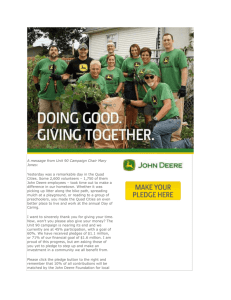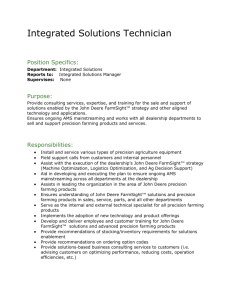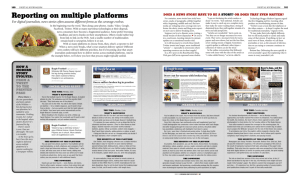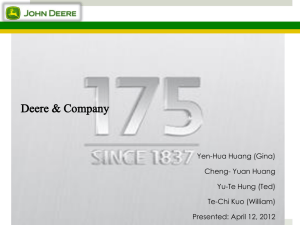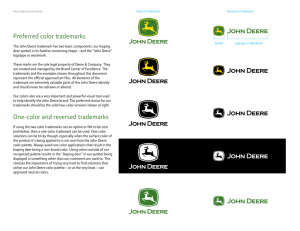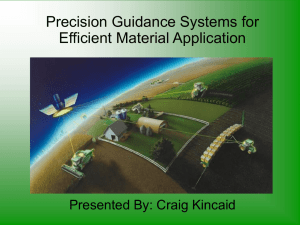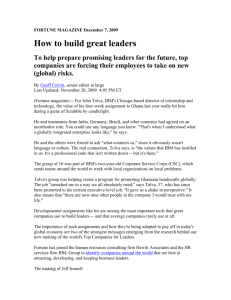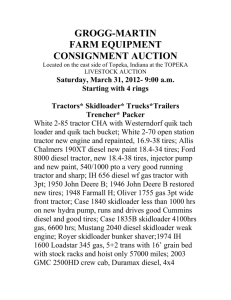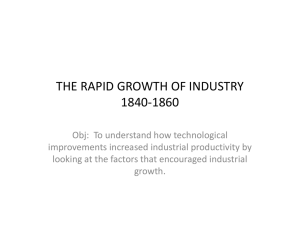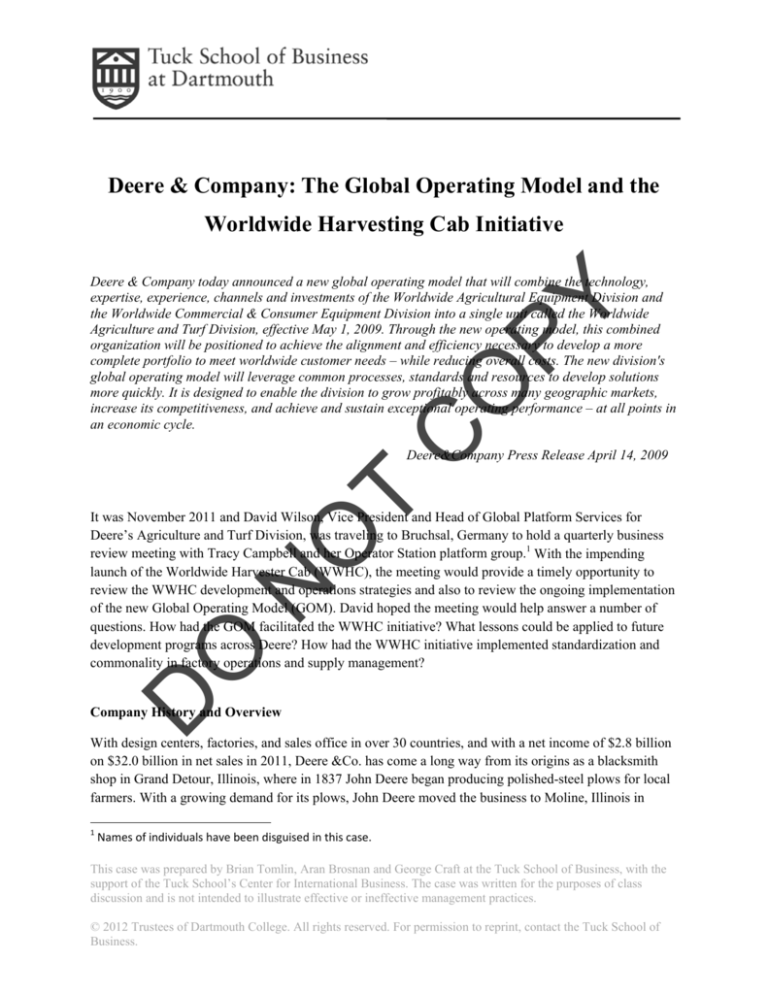
Deere & Company: The Global Operating Model and the
Worldwide Harvesting Cab Initiative
C
O
PY
Deere & Company today announced a new global operating model that will combine the technology,
expertise, experience, channels and investments of the Worldwide Agricultural Equipment Division and
the Worldwide Commercial & Consumer Equipment Division into a single unit called the Worldwide
Agriculture and Turf Division, effective May 1, 2009. Through the new operating model, this combined
organization will be positioned to achieve the alignment and efficiency necessary to develop a more
complete portfolio to meet worldwide customer needs – while reducing overall costs. The new division's
global operating model will leverage common processes, standards and resources to develop solutions
more quickly. It is designed to enable the division to grow profitably across many geographic markets,
increase its competitiveness, and achieve and sustain exceptional operating performance – at all points in
an economic cycle.
T
Deere&Company Press Release April 14, 2009
D
O
N
O
It was November 2011 and David Wilson, Vice President and Head of Global Platform Services for
Deere’s Agriculture and Turf Division, was traveling to Bruchsal, Germany to hold a quarterly business
review meeting with Tracy Campbell and her Operator Station platform group.1 With the impending
launch of the Worldwide Harvester Cab (WWHC), the meeting would provide a timely opportunity to
review the WWHC development and operations strategies and also to review the ongoing implementation
of the new Global Operating Model (GOM). David hoped the meeting would help answer a number of
questions. How had the GOM facilitated the WWHC initiative? What lessons could be applied to future
development programs across Deere? How had the WWHC initiative implemented standardization and
commonality in factory operations and supply management?
Company History and Overview
With design centers, factories, and sales office in over 30 countries, and with a net income of $2.8 billion
on $32.0 billion in net sales in 2011, Deere &Co. has come a long way from its origins as a blacksmith
shop in Grand Detour, Illinois, where in 1837 John Deere began producing polished-steel plows for local
farmers. With a growing demand for its plows, John Deere moved the business to Moline, Illinois in
1
Names of individuals have been disguised in this case. This case was prepared by Brian Tomlin, Aran Brosnan and George Craft at the Tuck School of Business, with the
support of the Tuck School’s Center for International Business. The case was written for the purposes of class
discussion and is not intended to illustrate effective or ineffective management practices.
© 2012 Trustees of Dartmouth College. All rights reserved. For permission to reprint, contact the Tuck School of
Business.
Deere & Co.: The Global Operating Model 1848. By 1912, Deere had 25 sales offices in the U.S. and Canada and 11 manufacturing facilities. The
emergence of the gasoline engine tractor in 1915 threatened to disrupt the agricultural equipment
industry, and Deere’s 1918 acquisition of a gasoline engine tractor producer was a pivotal moment in the
company’s history, with the tractor being one of its dominant products over the following century.
Deere’s product portfolio grew in the 1940s and 1950s with its entry into the construction-equipment
business. However, Deere did not expand its manufacturing footprint outside the U.S. and Canada until
1956, when it built an assembly factory in Mexico and acquired a majority interest in a German
agricultural equipment manufacturer.
O
PY
The following decade saw Deere’s footprint expand in Europe, South America and Africa. New product
introductions in 1960 paved the way for Deere to become the world’s largest manufacturer of agricultural
and industrial tractors and related equipment. The 1960’s also saw the company’s entry into consumer
markets, making and selling garden tractors. In the following decades Deere’s business grew both in scale
and complexity, with the company acquiring a forestry-equipment producer in 2000 and building or
acquiring a variety of production facilities in India (1998), Brazil (2004), Russia (2005) and China (2007).
Deere’s global footprint was not limited to production facilities; it also had technology centers in a range
of countries.
C
By 2008, Deere was organized into four divisions: Agricultural Equipment, Commercial & Consumer
Equipment, Construction & Forestry Equipment, and Financial Services. As described in the company’s
2008 Annual Report:
N
O
T
The company’s Equipment Operations generate revenues and cash primarily from the sale of
equipment to John Deere dealers and distributors. The Equipment Operations manufacture and
distribute a full line of agricultural equipment; a variety of commercial, consumer and
landscapes equipment and products; and a broad range of equipment for construction and
forestry. The company’s Financial Services primarily provide credit services, which mainly
finance sales and leases of equipment by John Deere dealers and trade receivables purchased
from the Equipment Operations.
O
The Agriculture division generated 64% of Deere’s $25.8 billion in net sales in 2008, with the
Commercial & Consumer division and the Construction & Forestry division accounting for 17% and 19%
respectively.
D
To be successful in their markets, Deere products must be technologically advanced and reliable and
come with effective after-sales field-support. Agricultural equipment, such as harvesters for example, are
highly sophisticated machines, integrating complex hardware, electronics and software. In fact, “today’s
large John Deere tractors have more lines of software code than early space shuttles [and Deere’s] GPS
technology can guide a tractor and implement in the field with near-perfect precision. This means less
overlap in tillage and chemical application, saving time and money and minimizing environmental
impacts.”2 Exhibit 1 shows a scene from the Virtual Reality Lab at Deere’s Waterloo Product Engineering
Center. Examples of Deere products are shown in Exhibit 2(a)-(c).
2
David Everitt, President, Agriculture and Turf Division – North America, Asia, Australia, and Sub‐Saharan and South Africa, and Global Tractor and Turf Products. Quote from speech to Ag Investment Summit, 10/20/11. The Tuck School of Business at Dartmouth
2
Deere & Co.: The Global Operating Model The Agriculture and Turf Division and the Global Operating Model
PY
Deere’s relentless expansion in the second half of the twentieth century created a global footprint of
design centers and factories that developed and manufactured products for different regions of the world.
Products and regions tended to have a large degree of autonomy in designing products, selecting
suppliers, running factories and managing distribution channels. Decentralization was a key
organizational philosophy. While this organizational model had served Deere well for a number of
decades, the increased competition and globalization in the 2000’s caused senior management to ask
whether the existing model was enabling Deere to fully leverage its expertise, technologies, talent, sales
channels and global footprint. There was a growing sense that the business was not as fast as it could be,
not as cost competitive as it needed to be, and that it was harder to do business with it than it should be.
O
In 2008, Deere began to develop a new organization structure and operating model. The Agriculture
Equipment and Commercial & Consumer Equipment divisions were combined to create the Worldwide
Agriculture and Turf Division in 2009. At the same time, Deere began the implementation of a new
Global Operating Model. The objective of this transformation was to significantly improve Deere’s ability
to understand and act on global market opportunities, to leverage global scale, to share resources, and to
optimize global product line results.
N
T
Customer driven: All efforts are aligned to understand, design and deliver a differentiated John
Deere experience to targeted customers.
Differentiating speed: Reduce cycle times to differentiate the customer experience and achieve
business results.
Standard Processes: Utilize globally standard processes, terminology and metrics.
Partner Collaboration: Integrate partners to generate shared value and drive business results.
Talent Development: Attract, rapidly develop and retain global talent (at all levels).
O
C
The Global Operating Model (GOM) was founded on five guiding principles.
O
To achieve the objective of better leveraging its global resources, the GOM organized the newly formed
Ag&Turf division into Customer Focus Regions, Product Platforms, Platform Services, Customer Focus
Services, Strategic Marketing, Core Enablers, Solutions, and Division Level Functions. See Exhibit 3 for
an illustration of the new organization structure.
D
Customer Focus Regions
Rather than grouping countries solely by geographic proximity, Deere analyzed customer needs and
market characteristics to identify collections of countries that exhibited sufficient similarities that Deere
could leverage to its own and to its customers advantage. For example, Australia was grouped with
Canada and the United States in one region. The four regions are shown in Exhibit 4. Each of the four
regions would be responsible for sales, tactical marketing and customer support and each had
accountability for its marketing strategy, profitability, and market share growth.
External Platforms
Deere’s extensive product line contained families of products that performed a similar set of functions;
for example, although different types of crops require different harvesting equipment, many of the
The Tuck School of Business at Dartmouth
3
Deere & Co.: The Global Operating Model underlying customer requirements are similar from one crop to another. So as to leverage these functional
similarities across products, Deere created five External Platforms: Tractors, Crop Harvesting, Turf and
Utility, Hay and Forage and Crop Care. Each external platform was to be managed as a profit center to
globally optimize its product and manufacturing portfolio.3 External platforms would have global
accountability for portfolio decisions, portfolio sourcing and product delivery. They would be responsible
for product planning, product development, product line management and production planning.
Platform Services
C
O
PY
The Platform Services organization was designed to be a shared service producing parts for and
delivering services to the External Platforms. Global Platform Services comprised three Internal
Platforms: Operator Station; Hydraulic Cylinders and Components & Fabrication. The intent of the
Internal Platforms was to efficiently leverage common components and systems across External Platforms
to enable effective technology development and to optimize asset usage. In addition to the Internal
Platforms, the Platform Services organization comprised Product Engineering Services, Manufacturing &
Manufacturing Engineering Services, Process Management and Business Process Transformation.
Managed as a cost center, the vision was for Platform Services to improve Deere’s overall
competitiveness by driving performance improvement through leverage and synergy across common
processes, capabilities, and components. The Platform Services organization chart is shown in Exhibit 5.
Customer Focus Services
T
The Customer Focus Service organization would be responsible for providing the four regions with
support and shared services in the areas of customer and product support and order fulfillment. O
Strategic Marketing
Core Enablers
N
The Strategic Marketing organization would be responsible for gathering and prioritizing customer needs
globally and to help inform the regions and external platforms on how to sustainably grow market share.
O
The Core enablers would be responsible for the worldwide management of standard processes, systems
and shared services in the areas of Finance, Human Resources and Information Technology.
D
Division Level Functions
Certain functions, such as Quality and Supply Management, would be managed as division level function
supporting the external platforms and customer-focus regions.
The Global Operating Model represented a major transformation of Deere’s structure, and its impact
would be felt across all facets of the organization. Taking Platform Services as an example, the GOM
would fundamentally alter a number of key dimensions. For example, prior to GOM, core technologies in
3
Whereas Customer Focus Regions were concerned with profitability by geography, External Platforms were concerned with profitability by product. The Tuck School of Business at Dartmouth
4
Deere & Co.: The Global Operating Model components, cylinders and operator stations were driven by individual product line requirements,
resulting in a technology portfolio that had potential for significant overlap and redundancies across
product lines. Perhaps not surprisingly, opportunities to share parts across products were not always
exploited. Post GOM, leveraging part commonality (while still being responsive to External Platform
needs) would receive a higher priority when creating technology roadmaps.
PY
The organization and vision for manufacturing engineering was also transformed by the GOM. Instead of
individual products and factories owning the deployment and development of manufacturing services and
competencies, the GOM created a Manufacturing/Manufacturing Engineering (MFG/ME) organization
within Platform Services. While certain MFG/ME resources would still be located at factories, the
MFG/ME Internal Platform would enable Deere to align these resources with their respective External
Platforms and would also enable the deployment of common manufacturing engineering processes, tools
and standards on a division-wide basis.
O
Decision Rights
T
C
As is the case for all globally complex business, crucial processes (such as translating customer
requirements into a product specification) have the potential to impact a range of internal constituents.
This introduces a natural organizational tension as different constituents have different perspectives and
objectives. While some level of tension is constructive and can lead to better outcomes, tension can
sometimes delay decisions and lead to globally suboptimal outcomes. To drive clarity and alignment on
critical functional and cross-functional business decisions, the GOM launched a key initiative called
Decision Rights.
N
O
Decision rights are the foundation for progress and speed in a globally distributed, matrix
organization. Without clarity on decision rights, at best the organization will be engaged in solving
the same issue multiple ways around the globe resulting in waste and confusion. At worst, issues
will be drowned in a swirl of debate and decisions will be continually questioned and revisited with
no progress as a result.
Vice President, Global Platform Services, Ag&Turf Division
O
-
D
The Decision Rights initiative identified and reviewed more than 150 potential decisions before settling
on approximately 80 critical decisions to focus on initially. These decisions were selected because they
fell into one or more of the following categories: the decision required strong cross-functional inputs and
interaction; authority for the final decision required clarity; and/or the decision rights were changing in
the GOM. For example, one such decision was the global manufacturing footprint and capacity for an
External Platform. For each of the decisions, the relevant functional leaders (e.g., an External Platform
head or a Customer Focus Regional head) were identified and assigned one of the following three
responsibilities:
P: Primary responsibility for making the decision. There could be only one primary for any given
decision.
S: Shared Responsibility for making the decision. Those with shared responsibility must agree on
the decision.
The Tuck School of Business at Dartmouth
5
Deere & Co.: The Global Operating Model C: Contributor of key input or information to the decision process. Contributors have no veto over
the decision.
PY
For example, the External Platform leader would have primary responsibility for the global manufacturing
footprint and capacity for the External Platform, while Internal Platforms, Manufacturing Engineering,
and Supply Management might be contributors to the footprint decision. In rare cases, the primary
responsibility for a decision might not reside with a functional leader but instead with a coordinating
mechanism, i.e., a council of various functional leaders. This Decision Rights initiative resulted in a
Decision Rights Matrix that characterized the above responsibilities (P, S, or C) for each of the critical
decisions, with the intent of driving decision-making clarity into the processes. The Matrix could be
accessed via the Deere intranet and it was intended to be living tool that could be expanded over time and
that could serve as a model for decisions at lower levels in the organization.
The Operator Station Internal Platform
C
O
With operators spending many hours a day maneuvering and controlling their equipment, the operator
station is a crucial element of agricultural turf & utility, construction and forestry products. The Operator
Station Internal Platform was one of the three Internal Platforms created by the new Global Operating
Model. It was responsible for the development (design) and production (manufacturing and sourcing) of
operator stations across the product portfolio, partnering with the External Product Lines and Platforms
that were its customers.
O
N
O
T
The Operator Station Internal Platform (OSIP) had a global reach, with 9 manufacturing locations and 5
design centers. In some instances, operator stations were procured from external suppliers. The OSIP
global footprint is shown in Exhibit 6. Manufacturing facilities were either standalone or imbedded
factories, where an imbedded factory was co-located on the site of an External Platform manufacturing
facility. One of the visions of the OSIP was to create a distinctive John Deere operator experience across
the product portfolio by working with the External Platforms to identify opportunities for commonality.
In addition, commonality would enable cost reduction. At its inception, the OSIP needed to both
implement the GOM vision as well as manage a number of existing development programs. One such
program was the Worldwide Harvesting Cab Initiative.
D
The Worldwide Harvesting Cab (WWHC) Initiative
Cabs are a key differentiator in harvesting products; with customers valuing comfort, technology, ease of
use and visibility. By 2007, Deere competitors such as New Holland, Krone and Claas had recently
introduced new cab designs while Deere’s combine-harvester cab design had not evolved significantly in
almost twenty years. Faced with increasing competition and market-share pressure, Deere launched a
multi-year program to develop a new generation of cabs for its harvester product portfolio, with a rolling
release scheduled to start in 2012. The interior and exterior of the new cab is shown in Exhibits 7 and 8.
With this next-generation cab having a planned production life in the range of 10-15 years, it was crucial
to develop an industry-leading product (as perceived by customers) that would be supported by an
effective global operations strategy. It was imperative to achieve alignment between the development
The Tuck School of Business at Dartmouth
6
Deere & Co.: The Global Operating Model strategy and the operations strategy because decisions in one domain would have significant implications
for the other.
PY
The development strategy for the WWHC applied a gates-and-milestones process that Deere uses for all
Enterprise Product Delivery Programs (EPDP). This activity-and-time based methodology focuses on
crisp program execution and rapid development cycles. Deere’s methodology is based upon 14 internal
sub-processes that work as an integrated team to develop optimal programs that meet customer and
business expectations. Examples of sub-processes include Customer Acquisition Integration, Product
Design, Manufacturing Design, and Supply Chain Integration. The methodology is highly structured with
detailed activities, activity sequencing, and tools and templates. However, the structure can be scaled by
the individual programs and focused on the specific needs of the program. These highly aligned teams
are responsible for defining the program efforts, gaining management approval, and executing based upon
the program bounds established and approved by the business management team. While all of the subprocesses participate in the development of the program, the methodology is focused on defining the best
solution with heavy emphasis on customer needs, business integration, and financial return.
O
T
C
O
The operations strategy embraced a “build-anywhere” concept that would be supported by a modular
assembly strategy and part commonality. With the build-anywhere concept Deere would be able to build
(almost) any variant of the cab in any of the production facilities chosen for the WWHC. In the modular
assembly strategy, components in close proximity in the cab would be brought to the assembly line
already assembled into fully tested modules. Modules can be thought of as building blocks that comprise
the major portion of the components and labor in the cab. Examples of modules are the steering column,
the roof assembly, the seat and command arm, and the cab structure. Modular design would allow Deere
to deliver extensive product variety from a limited set of module variants. To support this, module
variants would need to be designed to have consistent interfaces with the other modules and to allow
common production tooling across variants of a module.
D
O
N
For the WWHC, the main production activities would be cab-structure welding and cab assembly. Other
modules such as the roof assembly, steering column and seat & command arm would be procured as
(almost-complete) modules from either internal or external suppliers and then assembled into the cab. No
new factory was being constructed as part of the WWHC initiative. Production of the new cab would
occur in three of Deere’s existing production facilities: Bruchsal (Germany), Waterloo, Iowa (U.S.), and
Horizontina (Brazil). It was anticipated that the total annual production would by approximately 20,000
units, with Bruchsal accounting for 55%, Waterloo 25% and Horizontina 20%.4 Unlike Bruchsal which
was a standalone factory, the Waterloo and Horizontina cab facilities were imbedded factories. Bruchsal
would supply cabs to two Deere factories in Germany (Mannheim and Zweibrücken), one in Finland and
one in the Netherlands.
Welding operations were highly automated in Waterloo and Bruchsal but less so in Horizontina.
Assembly in Bruchsal had typically been much more automated than in Waterloo and Horizontina which
were more labor intensive. Exhibit 9 shows two views of the Bruchsal assembly line for tractor cabs;
recall that factories made cabs for different external platforms. Other differences existed, for example the
tractor assembly process was based on a synchronous flow in Bruchsal but an asynchronous flow in
4
To preserve confidentiality, all non‐public data about Deere costs and volumes and supplier metrics have been disguised in this case. The Tuck School of Business at Dartmouth
7
Deere & Co.: The Global Operating Model Waterloo. Also, the production-planning software differed across locations, as did some of the material
handling processes and equipment. Workers in all three factories were represented by some form of labor
union but the union form varied across countries, for example there was a Works Council in Germany.
Also, the specifics of the labor agreements, for example rules about job assignments, varied across
locations.
The WWHC Seat Decision
C
O
PY
Because increased part commonality was a goal of the WWHC initiative, the engineering, manufacturing
and supply management teams worked together to identify and evaluate opportunities for leveraging
common components across regions and products. One such opportunity was in the area of seats. With
comfort being a key customer requirement for cabs, the seat plays a central role in the operator
experience. As one customer said, “we live in these things all summer. I'd rather feel good at the end of
the day.” Seat design, and its integration with the other parts of the cab interior, was therefore a crucial
work stream in the overall development program. For harvester-cab engineering, most of the seat design
and integration team members were located in Germany. Because the seat accounts for a significant
portion of the overall cab cost, it would also be imperative to create an effective operations strategy for
seats.
O
T
For the most part, seat production is not vertically integrated in the agricultural and construction
equipment industries; original equipment manufacturers (OEMs) source seats from external suppliers.
Seat design is a somewhat collaborative effort between the OEM and supplier. The seat industry has three
major suppliers with a global presence: Grammer, Sears Manufacturing, and Commercial Vehicle Group.
There are also a number of niche and regional supplies in the industry.
O
N
Early on in the WWHC initiative, two potential suppliers were identified from the set of three global
players. Deere had extensive experience working with each of these suppliers (A and B) in the past.5
Supplier A had at least one manufacturing facility in each of the following regions: Asia, Europe, South
America and North America. Supplier B had a somewhat similar global footprint except that it lacked a
manufacturing facility in South America. Supplier A’s design center was located in the U.S., whereas
Supplier B’s was located in Europe.
D
There is a large degree of heterogeneity in customer preferences and perceptions when it comes to seats,
both within a geographic region but also across geographical regions. For example, while the typical
customer in one part of the world might prefer a softer seat, the typical customer in another part of the
world might prefer a firmer seat. In addition, customers were very knowledgeable about seat suppliers
and often exhibited strong preferences for a particular supplier. Upon sitting in a seat, some customers
could tell exactly which supplier it came from.
Deere conducted extensive market research to gather “voice-of-the-customer” data to inform its seat
design and to evaluate suppliers. Customers from all regions were asked to evaluate seats on more than
twenty dimensions. On average, Supplier A was better on some dimensions and Supplier B on others, but
5
To preserve confidentiality, supplier names are masked and all supplier metrics are masked. Furthermore, while there was variation in the supplier metrics, with each outperforming the other on certain dimensions, the case purposefully mixes these dimensions so that neither supplier can be identified. The Tuck School of Business at Dartmouth
8
Deere & Co.: The Global Operating Model neither was clearly superior. The market research did observe heterogeneity in customer preferences
within and across regions. On average, Supplier A was slightly preferred in Europe whereas Supplier B
was slightly preferred in North America and South America.
PY
Deere evaluated the cost of each supplier to supply each of its three production facilities. Table 1 below
presents the fully loaded (purchasing plus logistics) per-unit cost that each Deere production location
would experience from each seat supplier. The regional difference in fully loaded costs is driven partially
by the different manufacturing footprints of the suppliers. Based on past experiences, Deere also
evaluated the two suppliers on (i) ability to adhere to the seat development schedule, (ii) non-cost supply
metrics such as delivery and quality, technical support and “wavelength” [alignment and ease of doing
business], and (iii) product reliability, durability and warranty performance. The two suppliers were
relatively evenly matched on these dimensions.
C
O
Based on their evaluations, the WWHC engineering, manufacturing and supply management teams had to
decide on a seat strategy, and in particular, what degree of standardization to pursue. Should they
standardize on one supplier for all regions? If so, which supplier? Should they standardize within a
region but allow differences across regions? If so what supplier should each region choose? Should they
offer both seats in all regions?
Conclusion
D
O
N
O
T
As David Wilson settled into his seat for the return flight to the U.S., he mentally reviewed some of the
discussions from the Operator Station business meeting. There had been a general agreement that the
Worldwide Harvester Cab development program had been a success to date and that the program could be
used to highlight the benefits of the Global Operating Model. One aspect of the WWHC success was the
degree to which it had implemented commonality and standardization. However, it had been clear in the
meeting that different individuals in the Operator Station Internal Platform had somewhat different
perspectives on how much further to drive commonality and standardization in future programs. As the
plane took off, David’s thoughts turned to the quarterly review meeting with the Manufacturing/
Manufacturing Engineering Services organization that was to be held the following week at Deere’s
World Headquarters in Moline, Illinois. How would this organization view the merits of commonality and
standardization?
Supplier A Supplier B Table 1: Cost per-unit (in $) for seats at each Deere factory.
Bruchsal $1,600 $1,520 Deere Cab Factory Waterloo $1,360 $1,428 Horizontina $1,760 $1,900 For reasons of confidentiality, these costs are masked and do not represent the actual or
relative costs for the suppliers.
The Tuck School of Business at Dartmouth
9
Deere & Co.: The Global Operating Model C
O
PY
Exhibit 1: A scene from the Virtual Reality Lab at Deere’s Waterloo Product Engineering Center
T
O
D
O
N
Exhibit 2(a): Combine Harvester
The Tuck School of Business at Dartmouth
10
Deere & Co.: The Global Operating Model T
C
O
PY
Exhibit 2(b): Self-Propelled Sprayer
D
O
N
O
Exhibit 2(c): Large tractor
The Tuck School of Business at Dartmouth
11
Deere & Co.: The Global Operating Model O
PY
Exhibit 3: Illustration of the Global Operating Model structure
C
T
O
Exhibit 4: The Four Customer Focus Regions
D
O
N
The Tuck School of Business at Dartmouth
12
Deere & Co.: The Global Operating Model Exhibit 5: Platform Services Organization Chart
Vice President
Sr. Administrative
Assistant
Global Director
Product Engineering
PY
Global Director
Mfg. Engineering
Global Director
Operator Station
Internal Platform
O
Global Director
Cylinder Platform
Global Director
Business Process
Transformation
Global Director
Process Management
Director
Program Management
Office Implementation
C
Director
Fabrication&
Components Platform
T
Bruchsal
Mannheim
E. Moline
O
Waterloo
N
O
Exhibit 6: Operator Station Design and Manufacturing Global Footprint
Jiamusi
Tianjin, TEDA
Augusta
Monterrey
D
Pune
Horizontina
Montenegro
Design Center
Manufacturing Facility
The Tuck School of Business at Dartmouth
13
Deere & Co.: The Global Operating Model C
O
PY
Exhibit 7: Interior Views of the Worldwide Harvester Cab
D
O
N
O
T
The Tuck School of Business at Dartmouth
14
Deere & Co.: The Global Operating Model O
PY
Exhibit 8: Exterior View of the Worldwide Harvester Cab
C
D
O
N
O
T
Exhibit 9: Two Views of Tractor Cab Assembly Line in Bruchsal
The Tuck School of Business at Dartmouth
15
Deere & Co.: The Global Operating Model D
O
N
O
T
C
O
PY
The Tuck School of Business at Dartmouth
16

